
Blue Wildebeest
Name
Blue wildebeest, or common wildebeest or white-bearded wildebeest (Connochaetes taurinus)
Appearance
The blue wildebeest is identified by its long black mane and beard hanging from the neck and throat. It's dark silver-gray body is marked by dark vertical streaks running down the front quarters.
The horns of adult bulls are heavily bossed, and both cows and bulls grow these short, curved horns. Bulls measure about 1.5m at the shoulders and weigh 250 kg. Naturally, cows are slightly smaller and measure 1.4m at the shoulder, with a mass of about 180 kg.
Blue Wildebeest Breeding
The blue wildebeest breeds seasonally. After a gestation period of nine months, single calves are born during the summer months. Just a few minutes after birth, the calves are able to run with the rest of the herd.
Blue Wildebeest Behaviour
Blue wildebeest herds migrate seasonally. This is an effective survival strategy during both the wet and dry seasons, allowing the consumption of resources over large areas and curtailing over-utilisation.
Blue wildebeests are social animals, living in herds ranging from ten to a few thousand. When the herd is stationary, the bulls maintain and protect the territory.
Where they are found
The blue wildebeest is distributed in large parts of Southern Africa, but is concentrated to the northeastern regions of South Africa. Population numbers are drastically decreased due to fencing, which inhibits the blue wildebeest’s instinctive migration.
Field Notes
There are five known subspecies of blue wildebeest in Africa:
Connochaetes taurinus taurinus - blue wildebeest or bridled gnu
Connochaetes taurinus albojubatus - eastern white-bearded wildebeest
Connochaetes taurinus cooksoni - Cookson’s wildebeest
Connochaetes taurinus johnstoni - Nyassaland wildebeest
Connochaetes taurinus mearnsi - western white-bearded wildebeest
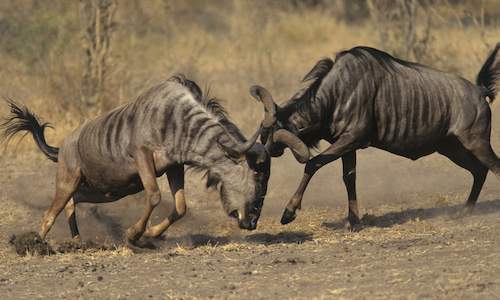
A typical blue wildebeest territory is usually positioned in the direct vicinity of water and somewhere nearby a sandy area that can be used...
more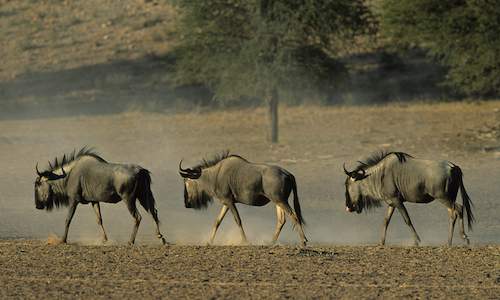
Open woodland, scrub and grassland, must have access to water and fresh pastures, not found abundantly where there are cold winters...
more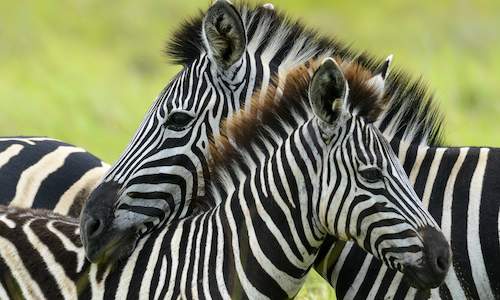
Learning about the mammals of South Africa is now so much easier for all South Africans - SouthAfrica.co.za is an excellent source of inform...
more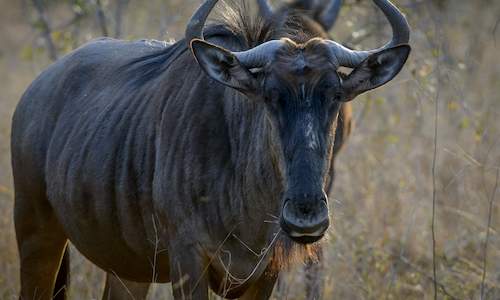
Wildebeest are very water dependent and they will drink daily even satisfying their thirst on muddied waters (unlike zebra)....
more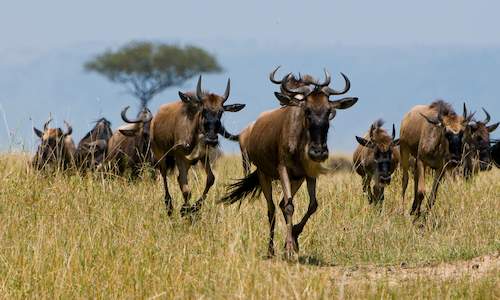
The populations of wildebeest have decreased due to the limitations imposed on their natural migration routes through Africa by fencing. The...
more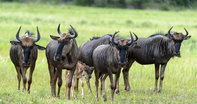
 A typical blue wildebeest territory is usually positioned in the direct vicinity of water and somewhere nearby a sandy area that can be used...
A typical blue wildebeest territory is usually positioned in the direct vicinity of water and somewhere nearby a sandy area that can be used... Open woodland, scrub and grassland, must have access to water and fresh pastures, not found abundantly where there are cold winters...
Open woodland, scrub and grassland, must have access to water and fresh pastures, not found abundantly where there are cold winters... Learning about the mammals of South Africa is now so much easier for all South Africans - SouthAfrica.co.za is an excellent source of inform...
Learning about the mammals of South Africa is now so much easier for all South Africans - SouthAfrica.co.za is an excellent source of inform... Wildebeest are very water dependent and they will drink daily even satisfying their thirst on muddied waters (unlike zebra)....
Wildebeest are very water dependent and they will drink daily even satisfying their thirst on muddied waters (unlike zebra).... The populations of wildebeest have decreased due to the limitations imposed on their natural migration routes through Africa by fencing. The...
The populations of wildebeest have decreased due to the limitations imposed on their natural migration routes through Africa by fencing. The...